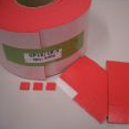Applications and Uses of Glazing Pads
- 2 November 2017
- Posted by: Madhuraka
- Category: Article
 As the label suggests, glazing pads are intended to protect glass panels. They’re made from a soft closed-cell material, a PVC foam that cushions flat glass. Used to protect scratch-prone plastic, soft metal, and breakable glass, the cushioning pads also perform well as product separation inserts, thanks to a superior compressibility feature. What about tacky marks, though? Won’t the adhesive leave a sticky residue on the new glass?
As the label suggests, glazing pads are intended to protect glass panels. They’re made from a soft closed-cell material, a PVC foam that cushions flat glass. Used to protect scratch-prone plastic, soft metal, and breakable glass, the cushioning pads also perform well as product separation inserts, thanks to a superior compressibility feature. What about tacky marks, though? Won’t the adhesive leave a sticky residue on the new glass?
A Residue-Free Cushion
The acrylic adhesive coating the single-sided glazing pad peels away without resistance. It grips the glass, holds it during transit, and then swings into action again as a partitioning insert when the glass is installed. All through the work, the little glazing blocks unmounts from the glossy surface without leaving behind a single ‘ghosting’ mark. That’s a feature glazing professionals can appreciate, a trait that saves time while protecting the glass.
Offers Non-Compressible Benefits
There are literally scores of cushioning inserts on the market, some of which meet the requirements of the automotive industry. Other products are ideal for satisfying the stringently enforced processing requirements in a plastics factory. Glossily painted vehicle panels are in transit in that former example, as are the glass windscreens that complete the bodywork. In the latter instance, a plastics factory, deformable panels and easy-scratch polymer sections are anchored in their boxes by special foam segments, a type of packaging that won’t damage the surface of a specified material. Glass, as we all know, is a little different. If the cushions holding that potentially brittle material push too hard, the panel will fracture. Now, if the glass is meant for a regular apartment, the flat plate is easily replaced. Imagine, though, a floor-to-ceiling plate of glass, perhaps one that’s intended for installation as a central pane in a French window. If that glass incurs even a tiny crack, the whole window is weakened. Fortunately, that talent for compression resistance introduces an inbuilt crack protector, a doughy closed-cell attribute that protects even the most brittle forms of glass.
Glazing pads protect fragile and scratch-prone flat panels. If the material in question is a soft but rigid plastic sheet, the little pillow blocks grip the material without cutting into the polymer. If the material is a glossy vehicle panel, the pads separate those parts. Finally, and this is where the glazing pads come into their own, the squared cushions will press together, but they won’t ever compress their load, which makes them the perfect peelable products for brittle glass. Better yet, the acrylic adhesive coating one side of the gripping pads is formulated so that it offers low tack pressure. In other words, when the pads are peeled away, there’s no messy adhesive residue left to clean up.

